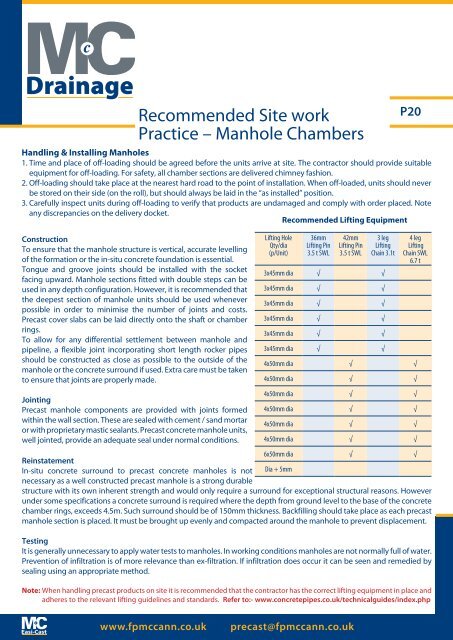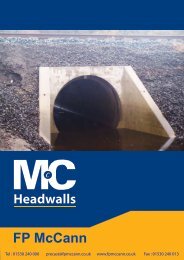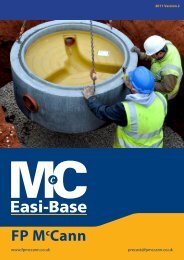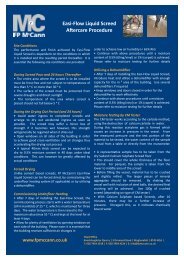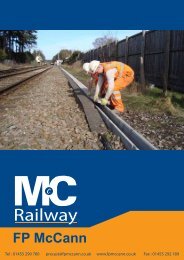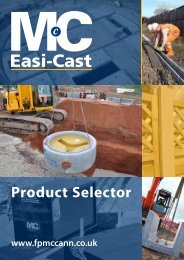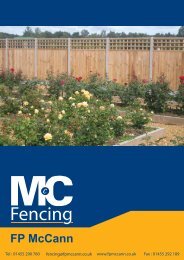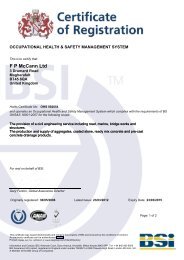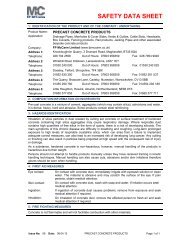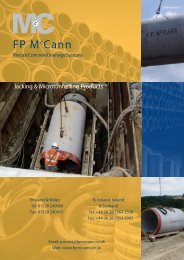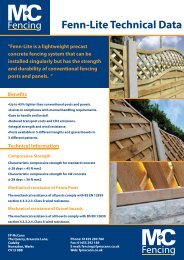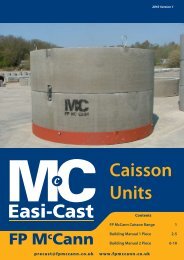Create successful ePaper yourself
Turn your PDF publications into a flip-book with our unique Google optimized e-Paper software.
Drainage<br />
Recommended Site work<br />
Practice – Manhole Chambers<br />
P20<br />
Handling & Installing Manholes<br />
1. Time and place of off-loading should be agreed before the units arrive at site. The contractor should provide suitable<br />
equipment for off-loading. For safety, all chamber sections are delivered chimney fashion.<br />
2. Off-loading should take place at the nearest hard road to the point of installation. When off-loaded, units should never<br />
be stored on their side (on the roll), but should always be laid in the “as installed” position.<br />
3. Carefully inspect units during off-loading to verify that products are undamaged and comply with order placed. Note<br />
any discrepancies on the delivery docket.<br />
Recommended Lifting Equipment<br />
Construction<br />
To ensure that the manhole structure is vertical, accurate levelling<br />
of the formation or the in-situ concrete foundation is essential.<br />
Tongue and groove joints should be installed with the socket<br />
facing upward. Manhole sections fitted with double steps can be<br />
used in any depth configuration. However, it is recommended that<br />
the deepest section of manhole units should be used whenever<br />
possible in order to minimise the number of joints and costs.<br />
Precast cover slabs can be laid directly onto the shaft or chamber<br />
rings.<br />
To allow for any differential settlement between manhole and<br />
pipeline, a flexible joint incorporating short length rocker pipes<br />
should be constructed as close as possible to the outside of the<br />
manhole or the concrete surround if used. Extra care must be taken<br />
to ensure that joints are properly made.<br />
Lifting Hole<br />
Qty/dia<br />
(p/Unit)<br />
36mm<br />
Lifting Pin<br />
3.5 t SWL<br />
42mm<br />
Lifting Pin<br />
3.5 t SWL<br />
3 leg<br />
Lifting<br />
Chain 3.1t<br />
3x45mm dia √ √<br />
3x45mm dia √ √<br />
3x45mm dia √ √<br />
3x45mm dia √ √<br />
3x45mm dia √ √<br />
3x45mm dia √ √<br />
4 leg<br />
Lifting<br />
Chain SWL<br />
6.7 t<br />
4x50mm dia √ √<br />
4x50mm dia √ √<br />
Jointing<br />
Precast manhole components are provided with joints formed<br />
within the wall section. These are sealed with cement / sand mortar<br />
or with proprietary mastic sealants. Precast concrete manhole units,<br />
well jointed, provide an adequate seal under normal conditions.<br />
Reinstatement<br />
In-situ concrete surround to precast concrete manholes is not<br />
necessary as a well constructed precast manhole is a strong durable<br />
4x50mm dia<br />
4x50mm dia<br />
4x50mm dia<br />
4x50mm dia<br />
6x50mm dia<br />
Dia + 5mm<br />
√<br />
√<br />
√<br />
√<br />
√<br />
√<br />
√<br />
√<br />
√<br />
√<br />
structure with its own inherent strength and would only require a surround for exceptional structural reasons. However<br />
under some specifications a concrete surround is required where the depth from ground level to the base of the concrete<br />
chamber rings, exceeds 4.5m. Such surround should be of 150mm thickness. Backfilling should take place as each precast<br />
manhole section is placed. It must be brought up evenly and compacted around the manhole to prevent displacement.<br />
Testing<br />
It is generally unnecessary to apply water tests to manholes. In working conditions manholes are not normally full of water.<br />
Prevention of infiltration is of more relevance than ex-filtration. If infiltration does occur it can be seen and remedied by<br />
sealing using an appropriate method.<br />
Note: When handling precast products on site it is recommended that the contractor has the correct lifting equipment in place and<br />
adheres to the relevant lifting guidelines and standards. Refer to:- www.concretepipes.co.uk/technicalguides/index.php<br />
20<br />
www.fpmccann.co.uk<br />
precast@fpmccann.co.uk


